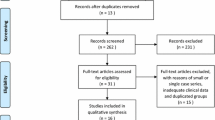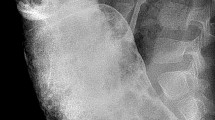Abstract
Purpose
The transanal one-stage pull-through procedure (TERPT) has gained worldwide popularity over open and laparoscopic-assisted one-stage techniques in children with Hirschsprung’s disease (HD). It offers the advantages of avoiding laparotomy, laparoscopy, scars, abdominal contamination, and adhesions. However, enterocolitis associated with Hirschsprung’s disease (HAEC) still remains to be a potentially life-threatening complication after pull-through operation. The reported incidence of HAEC ranges from 4.6 to 54%. This meta-analysis was designed to evaluate postoperative incidence of HAEC following TERPT procedure.
Methods
A meta-analysis of cases of TERPT reported between 1998 and 2009 was performed. Detailed information was recorded regarding intraoperative details and postoperative complications with particular emphasis on incidence of HAEC. Diagnosis of HAEC in a HD patient was based on the clinical presentation of diarrhoea, abdominal distension, and fever.
Results
Of the 54 published articles worldwide, 27 articles, including 899 patients were identified as reporting entirely TERPT procedure. Postoperative HAEC occurred in 92 patients (10.2%). Recurrent episodes of HAEC were reported in 18 patients (2%). Conservative treatment of HAEC was successful in 75 patients (81.5%), whereas in 17 patients (18.5%) surgical treatment was needed.
Conclusions
This systematic review reveals that TERPT is a safe and less-invasive procedure with a low incidence of postoperative HAEC.
Similar content being viewed by others
References
Kleinhaus S, Boley SJ, Sheran M et al (1979) Hirschsprung’s disease––a survey of the members of the surgical section of the American Academy of Pediatrics. J Pediatr Surg 14:588–597
Swenson O (1999) How the cause and cure of Hirschsprung’s disease were discovered. J Pediatr Surg 34:1580–1581
De la Torre-Mondragon L, Ortega-Salgado JA (1998) Transanal endorectal pull-through for Hirschsprung’s disease. J Pediatr Surg 33:1283–1286
Langer JC, Minkes RK, Mazziotti MV et al (1999) Transanal one-stage Soave procedure for infants with Hirschsprung’s disease. J Pediatr Surg 43:148–152
Albanese CT, Jennings RW, Smith B et al (1999) Perineal one-stage pull-through for Hirschsprung’s disease. J Pediatr Surg 34:377–380
Liu DC, Rodriguez J, Loe WA Jr (2000) Transanal mucosectomy in the treatment of Hirschsprung’s disease. J Pediatr Surg 35:235–238
Langer JC, Seifert M, Minkes RK (2000) One-stage Soave pull-through for Hirschsprung’s disease: a comparsion of the transanal and open approaches. J Pediatr Surg 35:820–822
De la Torre-Mondragon L, Ortega-Salgado JA (2000) Transanal versus open endorectal pull-through for Hirschsprung’s disease. J Pediatr Surg 35:1630–1632
Hoellwarth ME, Rivosecchi M, Schleef J et al (2002) The role of transanal endorectal pull-through in the treatment of Hirschsprung’s disease––a multicenter experience. Pediatr Surg Int 18:344–348
Teeraratkul S (2003) Transanal one-stage endorectal pull-through for Hirschsprung’s disease in infants and children. J Pediatr Surg 38:184–187
Erguen O, Celik A, Doekuemcue Z et al (2003) Submucosal pressure–air insufflation facilitates endorectal mucosectomy in transanal endorectal pull-through procedure in patients with Hirschsprung’s disease. J Pediatr Surg 38:188–190
Elhalaby EA, Hashish A, Elbarbary MM et al (2004) Transanal one-stage endorectal pull-through for Hirschsprung’s disease: a multicenter study. J Pediatr Surg 39:345–351
Hadidi A (2003) Transanal endorectal pull-through for Hirschsprung’s disease: experience with 68 patients. J Pediatr Surg 38:1337–1340
Murphy F, Puri P (2005) New insights into the pathogenesis of Hirschsprung’s associated enterocolitis. Pediatr Surg Int 21:773–779
Surana R, Quinn FMJ, Puri P (1994) Evaluation of risk factors in the development of enterocolitis complicating Hirschsprung’s disease. Pediatr Surg Int 9:234–236
Bill AH, Chapman ND (1962) The enterocolitis of Hirschsprung’s disease, its natural history and treatment. Am J Surg 103:70–74
Harrison MW, Deitz DM, Campbell JR et al (1986) Diagnosis and management of Hirschsprung’s disease. A 25-year perspective. Am J Surg 152:49–56
Ikeda K, Goto S (1984) Diagnosis, treatment of Hirschsprung’s disease in Japan. An analysis of 1628 patients. Ann Surg 199:400–405
Hackam DJ, Filler RM, Pearl RH (1998) Enterocolitis after the surgical treatment of Hirschsprung’s disease: risk factors and financial impact. J Pediatr Surg 33:830–833
Teitelbaum DH, Coran AG (1998) Enterocolitis. Semin Pediatr Surg 7:162–169
Vieten D, Spicer R (2004) Enterocolitis complicating Hirschsprung’s disease. Semin Pediatr Surg 13:263–272
Swenson O, Fisher J, Scott J (1960) Diarrhea following rectosigmoidectomy for Hirschsprung’s disease. Surgery 48:419–421
Hamdy MH (1974) Histochemical and physiological studies in Hirschsprung’s disease. M Ch Thesis, Alexandria University, Egypt, pp:37–60
Akkary S, Sahwy E, Kandil W et al (1981) A histochemical study of the mucosubstances of the colon in cases of Hirschsprung’s disease with and without enterocolitis. J Pediatr Surg 16:664–668
Fujimoto T, Puri P (1988) Persistence of enterocolitis following diversion of fecal stream in Hirschsprung’s disease. A study of mucosal defense mechanisms. Pediatr Surg Int 3:141–146
Teitelbaum DH, Caniano DA, Qualman SJ (1989) The pathophysiology of Hirschsprung’s-associated enterocolitis: importance of histologic correlates. J Pediatr Surg 24:1271–1277
Teitelbaum DH, Cilley RE, Sherman NJ et al (2000) A decade of experience with the primary pull-through for Hirschsprung’s disease in the newborn period: a multicenter analysis of outcomes. Ann Surg 232:372–380
Teitelbaum DH, Qualman SJ, Caniano DA (1988) Hirschsprung’s disease. Identification of risk factors for enterocolitis. Ann Surg 207:240–244
Elhalaby EA, Coran AG, Blane CE et al (1995) Enterocolitis associated with Hirschsprung’s disease: a clinical–radiological characterization based on 168 patients. J Pediatr Surg 30:76–83
Wildhaber BE, Pakarinen M, Rintala RJ et al (2004) Posterior myotomy/myectomy for persistent stooling problems in Hirschsprung’s disease. J Pediatr Surg 39:920–926
Hirschsprung H (1887) Stuhltreagheit Neugeborener in Folge von Dilatation und Hypertrophie des colons. Jahrbuch Kinderchir 27:1–7
Swenson O, Fisher JH (1956) Hirschsprung’s disease during infancy. Surg Clin North Am 36:115
Swenson O (1964) Sphincterotomy in the treatment of Hirschsprung’s disease. Ann Surg 160:540–550
Carneiro PMR, Brereton RJ, Drake DP et al (1992) Enterocolitis in Hirschsprung’s disease. Pediatr Surg Int 7:356–360
Moore SW, Albertyn R, Cywes S (1996) Clinical outcome and long-term quality of life after surgical correction of Hirschsprung’s disease. J Pediatr Surg 31:1496–1502
Sarioglu A, Tanyel FC, Buyukpamukcu et al (1997) Clinical risk factors for Hirschsprung’s associated enterocolitis II: postoperative enterocolitis. Turk J Pediatr 39:91–98
Fortuna RS, Weber TR, Tracy TF Jr et al (1996) Critical analysis of the operative treatment of Hirschsprung’s disease. Arch Surg 131:520–524
Reding R, De Ville de Goyet J, Gosseye S et al (1997) Hirschsprung’s disease: a 20-year experience. J Pediatr Surg 32:1221–1225
Rescorla FJ, Morrison AM, Engles D et al (1992) Hirschsprung’s disease. Evaluation of mortality and long-term function in 260 cases. Arch Surg 127:934–940
Suita S, Taguchi T, Ieiri S et al (2005) Hirschsprung’s disease in Japan: analysis of 3852 patients based on a nationwide survey in 30 years. J Pediatr Surg 40:197–201
Singh R, Cameron BH, Walton JM et al (2007) Postoperative Hirschsprung’s enterocolitis after minimally invasive Swenson’s procedure. J Pediatr Surg 42:885–889
Murthi GV, Raine PA (2003) Preoperative enterocolitis is associated with poorer long-term bowel function after Soave-Boley endorectal pull-through for Hirschsprung’s disease. J Pediatr Surg 38:69–72
Brearly S, Armstrong G, Nairn R et al (1987) Pseudomembranous colitis: a lethal complication of Hirschsprung’s disease unrelated to antibiotic usage. J Pediatr Surg 22:257–259
Thomas DFM, Fernie DS, Bayston R et al (1986) Enterocolitis in Hirschsprung’s disease: a controlled study of the etiologic role of Clostridium difficile. J Pediatr Surg 21:22–25
Polley T Jr, Coran AG, Wesley JR (1985) A ten-year experience with ninety-two cases of Hirschsprung’s disease. Including sixty-seven consecutive endorectal pull-through procedures. Ann Surg 202:349–355
Marty T, Seo T, Matlak M et al (1995) Gastrointestinal function after surgical correction of Hirschsprung’s disease: long-term follow-up in 135 patients. J Pediatr Surg 30:655–658
Author information
Authors and Affiliations
Corresponding author
Rights and permissions
About this article
Cite this article
Ruttenstock, E., Puri, P. Systematic review and meta-analysis of enterocolitis after one-stage transanal pull-through procedure for Hirschsprung’s disease. Pediatr Surg Int 26, 1101–1105 (2010). https://doi.org/10.1007/s00383-010-2695-1
Published:
Issue Date:
DOI: https://doi.org/10.1007/s00383-010-2695-1




